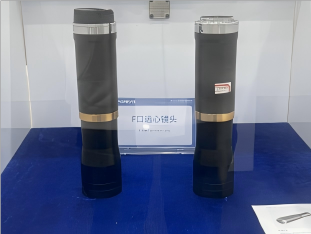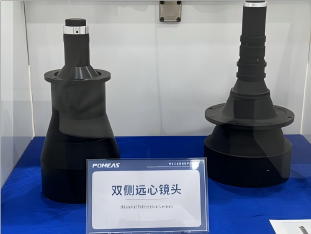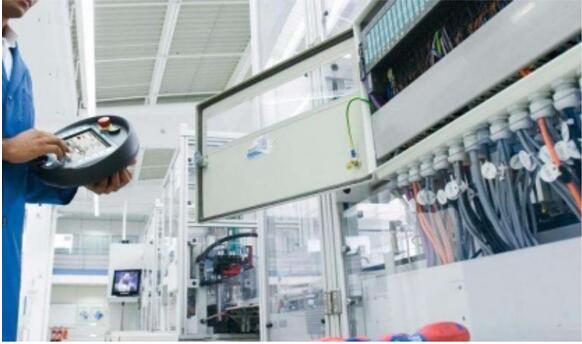1. What is an industrial lens?
Industrial lenses are lenses used to realize beam conversion (modulation), the main role is to image the target on the photosensitive surface of the image sensor. In the machine vision system, industrial lens as the core component to capture image information, its quality and selection is directly related to the accuracy and stability of the entire vision system. Industrial lenses are widely used in tasks such as image monitoring, quality inspection and automation control, and are key components in realizing automated quality control and production monitoring.


2. Industrial lens parameters in detail
-
Focal length (EFL): the distance from the center of the lens to the focal point of the image, determines the angle of view and magnification of the lens. The shorter the focal length, the larger the angle of view and the wider the range of observation; the longer the focal length, the smaller the angle of view and the narrower the range of observation.
-
Aperture (F-value): A device that controls the amount of light entering the lens, expressed as an F-value. The size of the aperture affects the brightness and depth of field of the image. The larger the aperture (the smaller the F-value), the more light is fed into the image, the brighter the image is, but the smaller the depth of field; the smaller the aperture (the larger the F-value), the less light is fed into the image, the darker the image is, but the greater the depth of field.
-
Working Distance: The distance from the lens to the subject determines whether the lens can work properly in a given space.
-
Field of View Size: The maximum area that can be captured by a lens, which is related to the focal length and working distance, and is a key indicator for evaluating the shooting range of a lens.
-
Resolution: the ability of the lens to record the details of the object, the higher the resolution, the clearer the lens imaging, the more details can be captured.
-
Aberration: Distortion produced by the image in shape, mainly including barrel distortion and cushion distortion, distortion will affect the accuracy of the measurement, in the precision measurement needs special attention.
-
Depth of field: in the scene space, located in the focusing object plane before and after a certain distance within the scene, but also be able to form a relatively clear image, the depth of this distance is called the depth of field.
-
Interface type: the connection port between the lens and the camera, you need to make sure that the two match, if you can't match directly, consider using an adapter.


3. Industrial lens inspection area
-
Product Quality Inspection: Used to detect defects, size, color, etc. to ensure product quality.
-
Non-destructive testing: In the detection of defects in materials such as metals, plastics and glass, industrial lenses can provide high-resolution, high-contrast images to help identify potential problems.
-
Security monitoring: City public security, banks, schools, shopping malls and other places of video surveillance equipment are using industrial lenses to achieve a full range of high-definition video surveillance.
-
Medical Imaging: Endoscopes, microscopes, CTs, X-ray machines and other medical equipment also require the use of industrial lenses to provide clear images to assist doctors in precise positioning and surgical operations.
4. Industrial lens selection highlights
-
Define the needs: According to the actual application scene, determine the focal length, aperture, working distance and other key parameters of the lens. Consider whether zoom function, measurement function, telecentric lens and other special needs are required.
-
Match the camera: Ensure that the interface type of the lens matches the interface type of the camera. The imaging circle diameter of the lens should be larger than the diagonal length of the camera's sensor chip to avoid image edge distortion.
-
Match resolution: The resolution of the lens should be higher than that of the camera to ensure the clarity of image details.
-
Calculate the focal length: According to the camera sensor size, working distance and field of view size, use the formula to calculate the required focal length. Select the appropriate focal length on the premise of satisfying the field of view.
-
Focus on MTF and aberration: Modulation transfer function (MTF) and aberration conditions have a significant impact on image quality, especially in measurement applications where low aberration lenses need to be selected.
-
Cost-effectiveness: Under the premise of meeting performance requirements, consider the cost-effectiveness of the lens and choose the most cost-effective solution.
Product recommendation
TECHNICAL SOLUTION
MORE+You may also be interested in the following information
FREE CONSULTING SERVICE
Let’s help you to find the right solution for your project!


 ASK POMEAS
ASK POMEAS  PRICE INQUIRY
PRICE INQUIRY  REQUEST DEMO/TEST
REQUEST DEMO/TEST  FREE TRIAL UNIT
FREE TRIAL UNIT  ACCURATE SELECTION
ACCURATE SELECTION  ADDRESS
ADDRESS Tel:+ 86-0769-2266 0867
Tel:+ 86-0769-2266 0867 Fax:+ 86-0769-2266 0867
Fax:+ 86-0769-2266 0867 E-mail:marketing@pomeas.com
E-mail:marketing@pomeas.com
